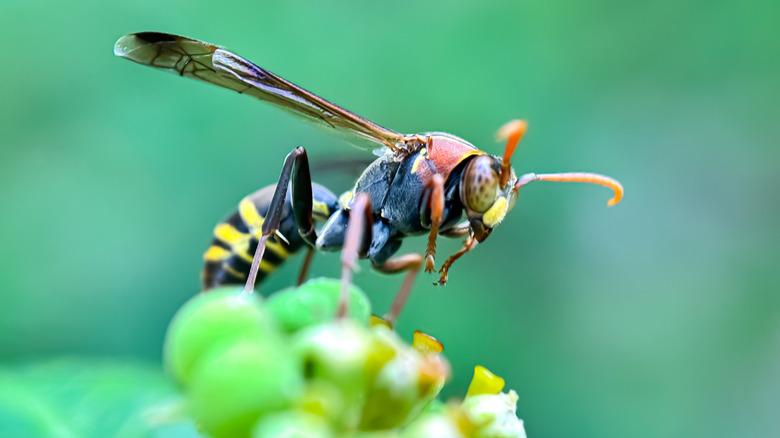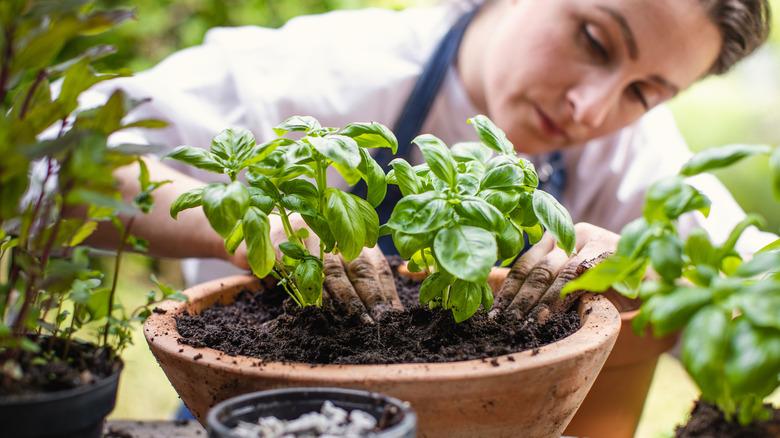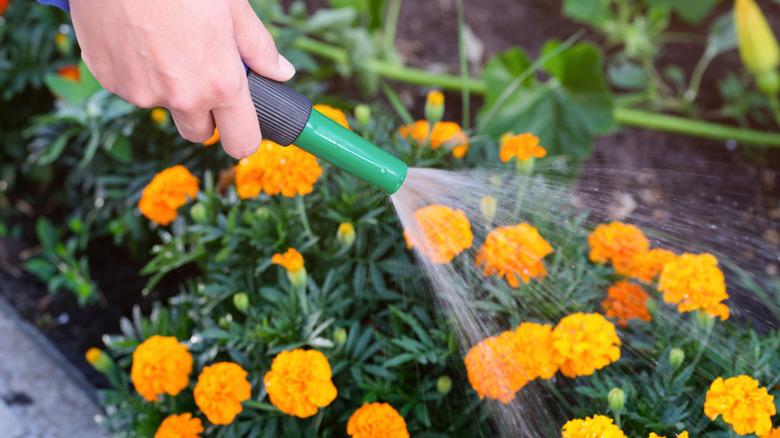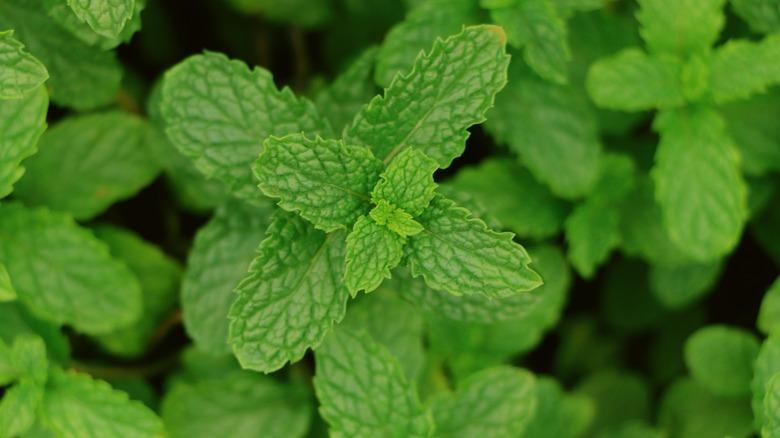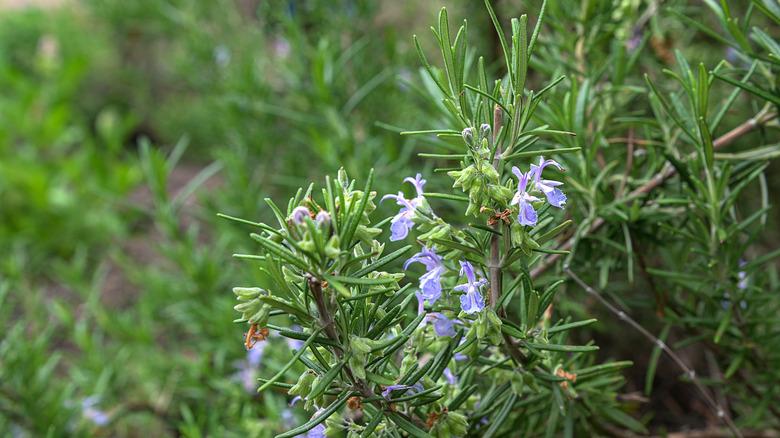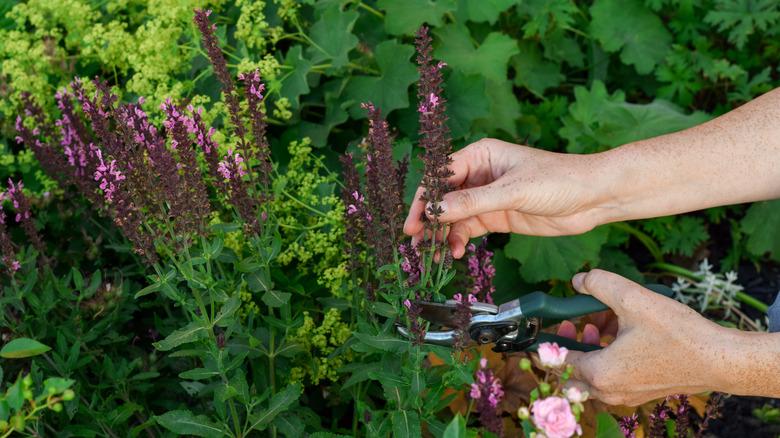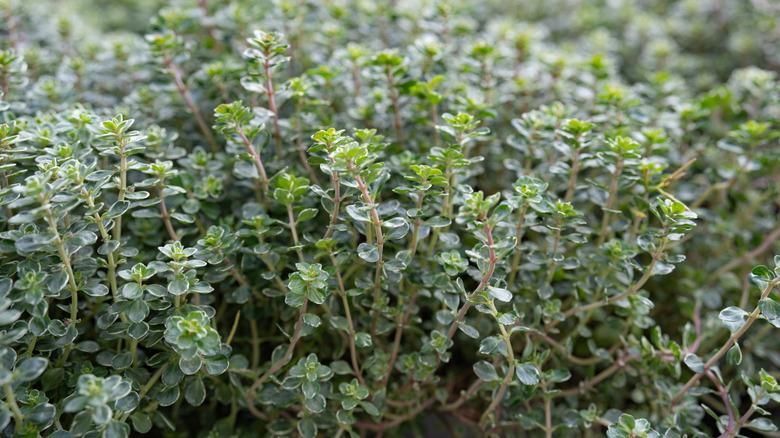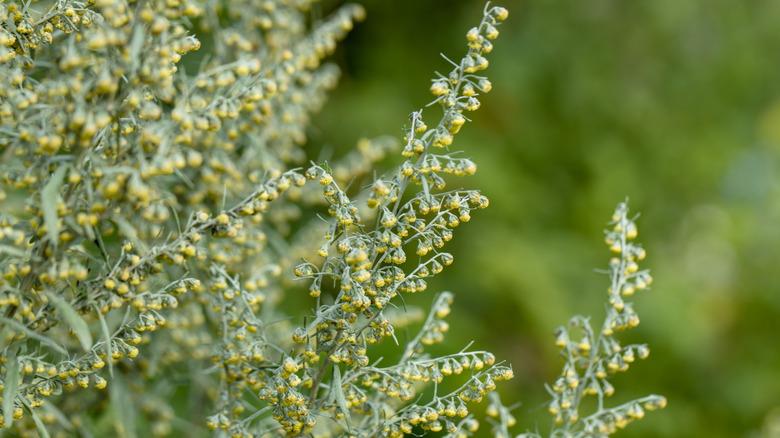11 Gorgeous Plants That Double As Natural Wasp-Repellents
Wasps are arguably among some of the most controversial flying insects. With the exception of nesting wasps, most of these insects are usually harmless to humans unless the wasps perceive that they are directly threatened. Experts also argue that wasps can play an important role in the overall ecosystem. While these pollinators are indeed important, there are also many reasons why you might want to help control their numbers in your outdoor spaces and prevent nesting. Before you resort to potentially harmful insecticides, you might consider using certain flowering plants and herbs that have a reputation for deterring these pests while looking great in your garden.
If using plants as natural wasp repellents sounds too good to be true, it turns out this method works thanks to wasps' incredibly sensitive sense of smell. Due to their dislike of strong aromas, there are numerous types of plants they may possibly avoid. Coincidentally, many of these wasp-repelling plants also belong to the strong-smelling mint family, but you have other options as well. Before planting any particular plant for aesthetic value or wasp repellent purposes, it's also important to know each individual plant's growing and maintenance needs.
Basil
When starting an herb garden, sweet basil (Ocimum basilicum) may be the first plant you think of, and for good reason. Traditional varieties have beautiful, bright green leaves, along with tiny white flowers. You can also mix up your herb garden with purple-leaf varieties, too, or even types that produce purple flowers, such as Thai basil. Regardless of the type of basil you plant, it will undoubtedly pair alongside other attractive plants you have outdoors. Plus, if you use basil for cooking on a frequent basis, nothing compares to being able to pluck fresh basil leaves from your own garden.
Not only is basil versatile, but it also has a fragrant scent that any gardener can appreciate. At the same time, many flying insects do not care for the sweet-peppery smell of basil leaves, and this includes wasps. As a bonus, basil is safe to plant around pets and children, as it doesn't pose any toxicity problems. Whether you grow basil directly in the ground or in containers, be sure to place your plants in an area of full sun along with well-draining soil, and to follow other rules of basil plant care and maintenance. Depending on the variety, basil may grow well in USDA hardiness zones 3 to 11.
Eucalyptus
Also known as "gum trees," eucalyptus (Eucalyptus spp.) is technically a member of the myrtle family. Of the more than 700 types of eucalyptus, the majority are indigenous to Australia. Depending on the variety, eucalyptus can be shrubs or they can grow upright into tall trees around your home. Not only can eucalyptus potentially grow into natural privacy screens, but they also boast interesting blue, gray, or silver leaves along with bell-shaped flowers. They grow best in warm, drier climates and in USDA hardiness zones 7 to 10.
While eucalyptus essential oil may help repel wasps due to its strong smell, some pest control companies advocate for planting eucalyptus for the same reasons. Eucalyptus oil is derived from the leaves of this plant, and it's thought that wasps might avoid them because of the strong, medicine-like scent. As a bonus, the plant may even repel mosquitoes. Consider planting them around areas of your yard or garden you frequent, such as the patio. You'll also want to ensure the plants get full sun. Just as experts recommend spraying diluted eucalyptus essential oil around your home's entry points as a natural pest control method, you might also consider placing potted eucalyptus plants near windows and doors to help repel wasps. You may even be able to dry the eucalyptus leaves for targeted use. As a major caveat, though, be aware that eucalyptus can be highly toxic to people or animals who ingest either the leaves or the bark of this plant.
Geraniums
Geraniums (Pelargonium spp.) produce vibrant flowers colors that primarily range from white to shades of pink and red. Certain varieties produce deep purple, yellow, orange, and lavender flowers. Some are even bi-colored or tri-colored. Regardless of the exact color of geraniums that blossom, these plants undoubtedly make any garden or flowerbed pop. Gardeners also appreciate the interesting foliage of geraniums, which can be segmented in varying colors of green, white, and even yellow or red.
Despite their attractive qualities to humans, not all flying insects appreciate geraniums. This includes wasps, who purportedly do not care for the scent of the plant's leaves. In fact, just as geraniums offer a variety of color, scented varieties have different leaf aromas wasps likely detest, including strong smells of peppermint, nutmeg, citrus, and more. Also, geraniums do not produce as much pollen as other flowers. While this attribute doesn't necessarily repel flying insects, less pollen might mean fewer wasps hanging around. Some pest control experts claim red geraniums may be even more of a deterrent to bees and wasps because they purportedly cannot see this color flower. Overall, geraniums need full sun, well-draining soil, and minimal fertilizer. They can also be planted in containers for easy shelter indoors on cooler nights. Geraniums grow best in USDA hardiness zones 9 to 11, and you will want to plant with caution around cats, dogs, and horses, as these plants are considered toxic to them.
Lavender
When evaluating plants that have aesthetic appeal while deterring certain pests, it's easy to see how lavender (Lavendula angustifolia) is a top contender. This perennial plant has a bushy quality that can work well when grown as hedges in flowerbeds, or you can contain their growth in smaller pots as part of a container garden. Not only does lavender boast spiky lavender- or white-colored flowers, but they also add some interest with their bluish or grayish needle-like leaves.
While you might love the floral and earthy smell of lavender flowers in your garden, it turns out that wasps do not care for them at all. Consider planting lavender in areas where wasps frequent your yard or garden. When considering how to grow and maintain lavender, keep in mind that the plant requires dry, well-draining soil, full sun, and air circulation. Know that bees will appreciate lavender flowers, and they are also considered important for the plant's pollination process. Depending on the exact variety, lavender usually does well in USDA hardiness zones 5 to 10. As another option, you can take dried lavender flowers and place them around entry points near your home to discourage wasps from coming close.
Marigolds
With their bright flowers of white, yellow, and orange, marigolds (Tagetes spp.) offer a multitude of benefits in a home garden. Perhaps the most obvious benefit is the flowers themselves, as the blooms can add beautiful coloring to your outdoor spaces. Marigolds are usually planted as annuals, which means you will need to replace them again next season to enjoy the flowers year-round. Depending on the variety, marigolds can be as small as 6 inches, or as tall as 4 feet. They are relatively easy to grow, and can thrive in USDA hardiness zones 2 to 11.
If you've ever seen marigolds planted in vegetable gardens, there's a good reason for this. The musky scent of marigold plants is thought to repel a variety of pests, including aphids, nematodes, mosquitoes, and wasps. The leaves of the plant are even thought to help deter rabbits and deer. You can easily grow marigolds in flower beds and vegetable gardens, although smaller Signet varieties may be grown in pots if you have a container garden. Regardless of the variety, marigolds do best in areas of full sun, though you may also be able to grow a marigold as a house plant, too.
Mint
One of the most commonly grown herbs is the mint (Mentha spp.) plant. It's particularly beginner-friendly and can grow under some of the toughest conditions. From an aesthetic perspective, though, mint can also be a beautiful addition to container gardens. The plant produces small dark green leaves that give off a lovely, strong aroma for anyone who passes by. On top of this, different types of mint plants can also produce blue, purple, or white flowers. The hardy plant can be grown in USDA hardiness zones 3 to 11, with some variations depending on the different types of mint plants.
While you might appreciate the beauty and aroma of mint, it's thought that wasps are among the many flying insects that are turned off by the strong scent of the plant's leaves. The biggest caveat to growing mint involves the aggressive nature of the plant, as it can quickly take over other plants in flowerbeds and gardens. You can help prevent mint from becoming a weed by keeping it in containers. The plant also does well in part to full sun, which can allow you to strategically place containers of mint around entryways and other areas where wasps like to hang out in your outdoor spaces.
Rosemary
If you enjoy cooking hearty soups and stews, chances are you've used rosemary (Rosemarinus officinalis) from time to time. The herb also offers a number of benefits in a home garden. Not only does home-grown rosemary offer you the chance to use fresh leaves in your recipes, but the perennial shrub also adds visual interest and beauty to a garden with its green needle-like leaves and white, blue, or pink flowers. What's more, the flowers can benefit certain pollinating species, such as butterflies and bees.
If you've ever been around a rosemary plant or fresh rosemary leaves, you know they can have a strong pine tree-like smell. It's this very pungent quality that wasps are said to despise. While studies on the wasp-repelling qualities of rosemary plants are lacking, there is research backing the essential oil version as being able to ward off these insects. In theory, the plants themselves could offer similar effects, and the overall efficacy of this method is supported with anecdotal reports. Before planting rosemary in your garden, know that this plant does best in warmer climates and in USDA hardiness zones 8 and above. Consider growing rosemary in containers around your garden in areas of full sun for best results. It's also important to be aware of common problems with rosemary plants, such as overwatering.
Sage
Indigenous to areas of the northern Mediterranean region, sage (Salvia officinalis) is a type of perennial that can add both beauty and aroma to your home garden. It can be planted in USDA hardiness zones 4 to 10, where the shrub can easily get over 2 feet tall (though it may need cold weather protection in zones 4-5). As sage grows, you will witness interesting leaves that have pebble-like textures, and can range in color from gray to green or purple, depending on the cultivar. During the early summer months, butterflies, bees, and hummingbirds may stop by to check out the plant's lavender-colored flowers, which smell like camphor. The woody nature of the shrub, along with its muted colors, can work well with bright green plants you might already have in your garden.
Interestingly, the word "sage" also translates to "wise," and the herb has been used in cooking and in medicine since the ancient Romans. It turns out that perhaps another wise use of the herb could be as a natural wasp repellent. Sage is another aromatic herb that wasps purportedly do not care for in essential oil form, but it may be worth planting a few of these flowering plants in your yard as well. For best results when considering how to grow sage, plant them along borders in well-draining soil, and in areas with full sun.
Thyme
Thyme (thymus) is perhaps one of the most popular cooking herbs due to its versatility and earthy flavor. As a member of the mint family, the genus thyme actually boasts more than 350 species that also offer different fragrances ranging from citrus-like qualities to even oregano or nutmeg. In addition to keeping a bottle of thyme in your pantry, you might consider growing the perennial herb in your own garden. Not only does the evergreen-like foliage of this plant add visual interest to any outdoor space, but it also boasts small flowers in white, lavender, pink, or purple.
While many humans love the earthy smell and taste of thyme leaves, the opposite is true of wasps. The insects purportedly do not care for the smell of thyme, and they may steer clear of the plant altogether. When planting thyme for both aesthetics and wasp repellent properties, consider focusing on flowerbed edges. This will help create a barrier between wasps and the rest of your garden. Know that thyme flowers often attract other types of pollinating species, such as bees and butterflies. Thyme plants are considered hardy and low-maintenance, but they still require well-draining soil and occasional stem cuttings to grow their best. When considering how to grow common thyme, know that the plant needs full sun, and it grows well in USDA hardiness zones 5 to 9.
Wormwood
While perhaps not as well-known as other perennial plants, wormwood (Artemisia absinthium) is yet another herb that can look great in your garden and help repel wasps at the same time. Also known as common wormwood or absinthium, this plant is indigenous to Eurasia, and it sometimes crops up as weeds in northern portions of the U.S., so be careful to check with state and local regulations for invasive plants. When planted with care, though, wormwood can complement gardens with bright-colored flowering plants thanks to its muted grayish leaves and yellow flowers. The plant itself is also appropriate for USDA hardiness zones 3 to 9.
When it comes to wasps, the bitter aroma of the leaves of the wormwood plant are thought to be off-putting to these flying insects. You can help create these effects by planting wormwood into the ground, or in planters. Just be aware that wormwood grows slowly from seed, and they do best with around 5 feet of space between plants. Once they start growing though, wormwood plants can grow to around 3 feet tall. Whether you plant wormwood in pots or in garden beds, know that the plant does particularly well in areas of full sun, but it still requires well-draining soil due to the risk of root rot. Alternatively, if you have an active wasp problem in your outdoor spaces, you can try a targeted strategy with dried wormwood leaves from your plants. Simply crush these by hand and place the dried leaves near doors, windows, and other areas outside to deter the wasps from flying inside your home. Also keep in mind that the leaves can be toxic to humans and pets when ingested.
